Right this moment (April 26, 2023), the Australian Bureau of Statistics launched the most recent – Shopper Worth Index, Australia – for the March-quarter 2023. It confirmed that the CPI rose 1.4 per cent within the quarter (down 0.4 factors) and over the 12 months by 7 per cent (down 0.8 factors). The month-to-month knowledge, additionally launched right this moment (which I don’t analyse right here) exhibits inflation dropping from 7.4 per cent in January to six.8 per cent in February to six.3 per cent in March. Important downward development as the provision components abate. Taken collectively we conclude that the height has now handed, which is according to my evaluation that this may be a transient, supply-driven occasion. There are not any wage pressures and inflationary expectations are in decline or regular. The laughable factor is that as the speed falls, the mainstream narrative, which continues to push for greater rates of interest, has shifted from a deal with the inflation charge itself to the declare that it’s no longer falling quick sufficient. The claimed fears at the moment are that the longer it stays at elevated ranges the extra likelihood there will likely be of a wage-price spiral breaking out and/or accelerating (un-anchored) expectations. Neither are doubtless given the state of affairs earlier than us and that results in the conclusion that these rate of interest boosters are simply exuding sizzling air as ordinary. The most important sources of worth will increase are momentary and within the March-quarter are the direct results of discretionary authorities administrative preparations (indexation preparations and so forth), which may simply be waived this 12 months. The right coverage response needs to be to supply fiscal help for lower-income households to assist them address the price of residing rises at current. Growing rates of interest once more won’t resolve the issue that’s already abating.
The abstract, seasonally-adjusted Shopper Worth Index outcomes for the March-quarter 2023 are as follows:
- The All Teams CPI rose by 1.4 per cent for the quarter – 0.4 factors down from the final quarter.
- The All Teams CPI rose by 7 per cent over the 12 months (a decline from 7.8 per cent within the December-quarter 2022).
- The most important determinants have been Medical and hospital companies (+4.2 per cent), Tertiary training (+9.7 per cent), Fuel and different family fuels (+14.3 per cent), and Home vacation journey and lodging (+4.7 per cent).
- The Trimmed imply collection rose by 1.2 per cent for the quarter (down 0.5 factors) and 6.6 per cent over the earlier 12 months.
- The Weighted median collection rose by 1.2 per cent (down 0.4 factors) for the quarter and 5.8 per cent over the earlier 12 months.
The ABS Media Launch notes that:
CPI inflation slowed within the March quarter, with the quarterly rise being the bottom since December 2021. Whereas costs continued to rise for many items and companies, many of those will increase have been smaller than they’ve been in current quarters …
Costs for medical and hospital companies usually rise within the March quarter as GPs and different well being service suppliers assessment their session charges, and the Medicare Security Web is reset firstly of the calendar 12 months. This 12 months some personal medical health insurance premiums additionally elevated in January, including to the value rise for medical and hospital companies …
Tertiary training charges are additionally listed firstly of the 12 months …
greater wholesale fuel costs … mirrored main occasions over the previous 12 months together with the continuing conflict in Ukraine and unplanned outages at coal fired energy stations …
Meals costs … shortages attributable to moist climate …
Fruit costs …. attributable to damaging climate …
Quick evaluation:
1. The inflation charge is falling considerably every quarter – and word that the central financial institution boosters are all now shifting their narratives from uncontrolled inflation to silly claims that ‘it’s not falling quick sufficient’.
2. Look at the present drivers – they don’t mirror extreme demand in any respect.
They point out administrative preparations (indexation preparations, annual evaluations) that are the direct duty of presidency – for instance, the federal government may waive the indexation of college charges this 12 months and the inflation charge would drop considerably.
Additionally they indicated unhealthy climate – floods, fires and so forth.
Not one of the drivers could possibly be mentioned to be curiosity delicate, which then calls into query all the macroeconomic technique the place the RBA is attempting to intentionally create unemployment to suppress incomes and spending.
How will rate of interest rises cease the conflict within the Ukraine?
How will rate of interest rises repair up the awful climate?
Developments in inflation
The headline inflation charge elevated by 1.4 per cent within the March-quarter 2023 a 0.4 factors fall over the quarter.
Over the 12 months to December the inflation charge was 7.4 per cent (down 0.4 factors).
The next graph exhibits the quarterly inflation charge because the December-quarter 2005.
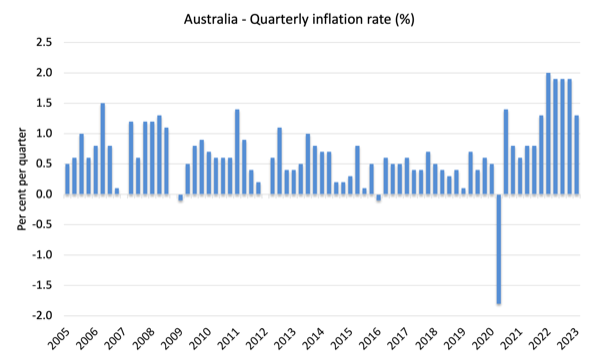
The following graph exhibits the annual headline inflation charge because the first-quarter 2002. The shaded space is the RBA’s so-called targetting vary (however learn under for an interpretation).
The development inflation charge (dotted line) which displays labour prices and productiveness development will reassert itself as soon as the momentary components abate is downwards.
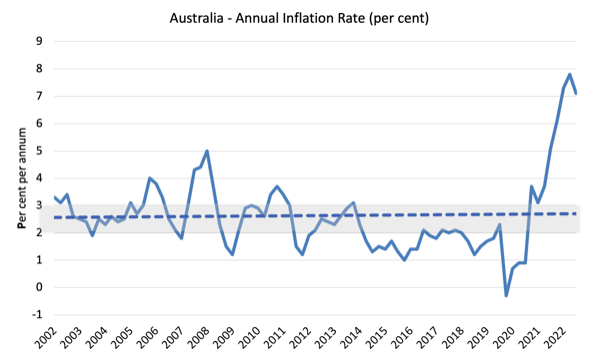
What’s driving inflation in Australia?
The next bar chart compares the contributions to the quarterly change within the CPI for the March-quarter 2023 (blue bars) in comparison with the December-quarter 2022 (inexperienced bars).
Be aware that Utilities is a sub-group of Housing and never insignificantly displays authorities administrative choices
The Recreation and tradition inflation from the final quarter represented a bounce-back from the restricted motion within the final two years as borders open and nations loosen up journey necessities.
I predicted in January that it will normalise over the subsequent few months and that was an accurate evaluation.
The Training worth inflation is because of authorities indexation preparations.
The impacts of the unhealthy floods on meals costs stays an issue.
A lot of the inflationary pressures proceed to be pushed by supply-side components and/or reflecting non-competitive and unregulated cartel-type behaviour and authorities coverage selections.
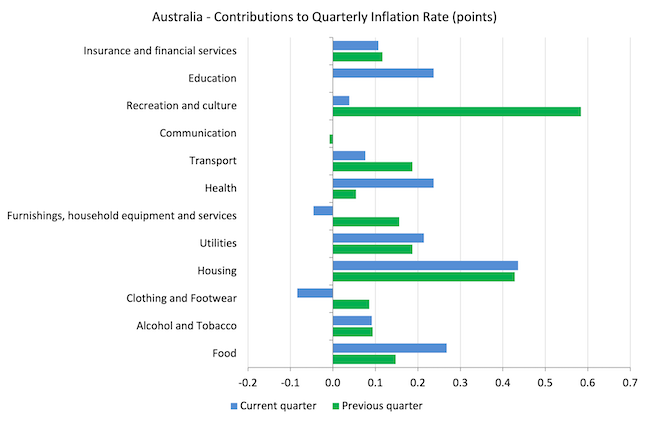
The following graph exhibits the contributions in factors to the annual inflation charge by the varied parts.
The principle drivers will disappear in coming quarters given their origin (see above).
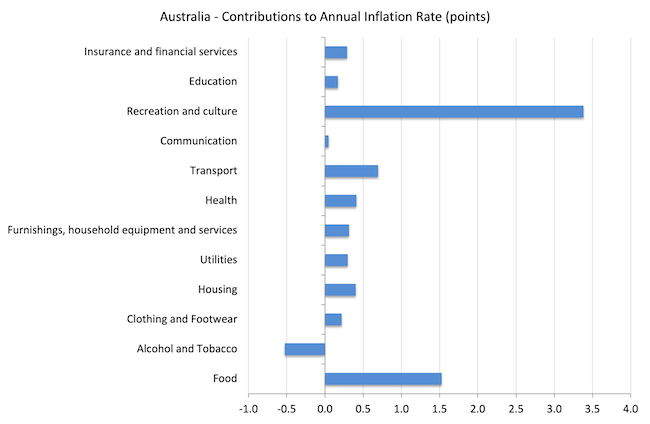
Inflation and Anticipated Inflation
The next graph exhibits 4 measures of anticipated inflation produced by the RBA – Inflation Expectations – G3 – from the December-quarter 2005 to the December-quarter 2021.
The 4 measures are:
1. Market economists’ inflation expectations – 1-year forward.
2. Market economists’ inflation expectations – 2-year forward – so what they assume inflation will likely be in 2 years time.
3. Break-even 10-year inflation charge – The typical annual inflation charge implied by the distinction between 10-year nominal bond yield and 10-year inflation listed bond yield. It is a measure of the market sentiment to inflation threat. That is thought-about probably the most dependable indicator.
4. Union officers’ inflation expectations – 2-year forward.
However the systematic errors within the forecasts, the value expectations (as measured by these collection) at the moment are falling or comparatively steady.
Nevertheless, within the case of the Market economists’ inflation expectations – 2-year forward and the Break-even 10-year inflation charge, the expectations stay effectively inside the RBA’s inflation targetting vary (2-3 per cent) and present no indicators of accelerating.
So all of the speak now’s that inflation just isn’t falling quick sufficient – and that declare is accompanied by claims that the longer it stays above the inflation targetting vary, the extra doubtless it’s {that a} wage-price spiral and/or accelerating (unanchored) expectations will drive the speed up for longer.
Neither declare might be remotely justified given the info.
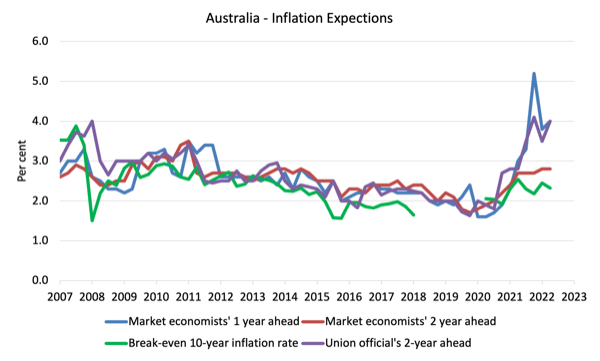
Implications for financial coverage
What does this all imply for financial coverage?
Most commentators – trying on the annual headline determine of seven.4 per cent – declare the RBA has no choice however to hike charges even additional not as a result of inflation is rising (that narrative has gone) however as a result of it’s not falling quick sufficient.
I’ve touched on that storyline above and dismiss it outright.
The RBA already has been grossly negligent in its choices to elevate charges 10 instances since Might 2023.
There was by no means a justification with an evidential-basis for these choices.
The rate of interest rises have been by no means going to quell the components contributing to the inflationary pressures and the one results of the hikes has been to badly damage low-income households with housing mortgages, a lot of whom overextended themselves on the again of statements by the RBA governor that they’d not elevate charges till 2024.
The Shopper Worth Index (CPI) is designed to mirror a broad basket of products and companies (the ‘routine’) that are consultant of the price of residing. You’ll be able to be taught extra in regards to the CPI routine HERE.
The RBA’s formal inflation concentrating on rule goals to maintain annual inflation charge (measured by the buyer worth index) between 2 and three per cent over the medium time period.
Nevertheless, the RBA makes use of a spread of measures to determine whether or not they imagine there are persistent inflation threats.
Please learn my weblog put up – Australian inflation trending down – decrease oil costs and subdued economic system – for an in depth dialogue about the usage of the headline charge of inflation and different analytical inflation measures.
The RBA doesn’t depend on the ‘headline’ inflation charge. As an alternative, they use two measures of underlying inflation which try to internet out probably the most unstable worth actions.
The idea of underlying inflation is an try to separate the development (“the persistent part of inflation) from the short-term fluctuations in costs. The principle supply of short-term ‘noise’ comes from “fluctuations in commodity markets and agricultural situations, coverage adjustments, or seasonal or rare worth resetting”.
The RBA makes use of a number of completely different measures of underlying inflation that are usually categorised as ‘exclusion-based measures’ and ‘trimmed-mean measures’.
So, you’ll be able to exclude “a specific set of unstable objects – particularly fruit, greens and automotive gas” to get a greater image of the “persistent inflation pressures within the economic system”. The principle weaknesses with this methodology is that there might be “giant momentary actions in parts of the CPI that aren’t excluded” and unstable parts can nonetheless be trending up (as in power costs) or down.
The choice trimmed-mean measures are fashionable amongst central bankers.
The authors say:
The trimmed-mean charge of inflation is outlined as the typical charge of inflation after “trimming” away a sure proportion of the distribution of worth adjustments at each ends of that distribution. These measures are calculated by ordering the seasonally adjusted worth adjustments for all CPI parts in any interval from lowest to highest, trimming away those who lie on the two outer edges of the distribution of worth adjustments for that interval, after which calculating a mean inflation charge from the remaining set of worth adjustments.
So that you get some measure of central tendency not by exclusion however by giving decrease weighting to unstable components. Two trimmed measures are utilized by the RBA: (a) “the 15 per cent trimmed imply (which trims away the 15 per cent of things with each the smallest and largest worth adjustments)”; and (b) “the weighted median (which is the value change on the fiftieth percentile by weight of the distribution of worth adjustments)”.
So what has been taking place with these completely different measures?
The next graph exhibits the three major inflation collection printed by the ABS because the December-quarter 2009 – the annual proportion change within the All objects CPI (blue line); the annual adjustments within the weighted median (inexperienced line) and the trimmed imply (pink line).
The RBAs inflation targetting band is 2 to three per cent (shaded space). The info is seasonally-adjusted.
The three measures are in annual phrases:
1. CPI measure of inflation rose by 7.1 per cent (down from 7.8 per cent final quarter). For the quarter it rose by 1.4 factors (down from 1.9)
2. The Trimmed Imply rose 6.6 per cent (down from 6.9 per cent final quarter). For the quarter it rose 1.2 factors (down from 1.7).
3. The Weighted Median rose 5.8 per cent (up from 5.6 per cent final quarter). For the quarter it rose by 1.2 factors (down from 1.6).
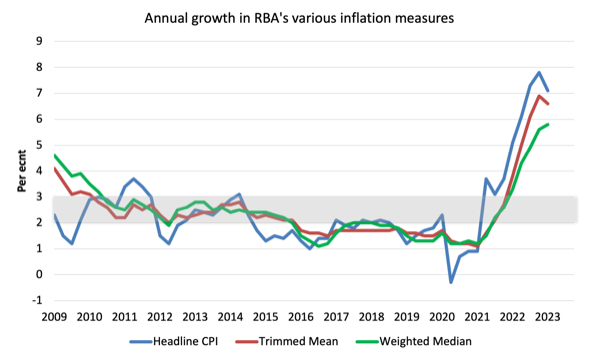
Find out how to we assess these outcomes?
1. The RBA’s most popular measures at the moment are outdoors the targetting vary and would usually set off an rate of interest rise.
2. Nevertheless,there isn’t any proof that inflationary expectations are accelerating.
3. Whereas all collection rose over the quarter on an annual foundation, all three measures confirmed a decline within the development for the quarter.
3. The most important drivers of the inflation are principally pushed by components that the RBA can not deal with by rate of interest rises – power costs, floods, and bushfires.
4. There isn’t any wages strain.
5. The opposite main contributors to the present state of affairs are additionally not delicate to rate of interest rises.
6. There isn’t any main structural bias in the direction of persistently greater inflation charges.
Conclusion
The annual inflation charge in Australia was considerably decrease within the December-quarter and the height is now gone.
The month-to-month knowledge, additionally launched right this moment (which I don’t analyse right here) exhibits inflation dropping from 7.4 per cent in January to six.3 per cent in March.
The most important sources of worth will increase are momentary and a few are the direct results of discretionary authorities administrative preparations (indexation preparations and so forth), which may simply be waived this 12 months.
The right coverage response needs to be to supply fiscal help for lower-income households to assist them address the price of residing rises at current.
That’s sufficient for right this moment!
(c) Copyright 2023 William Mitchell. All Rights Reserved.
